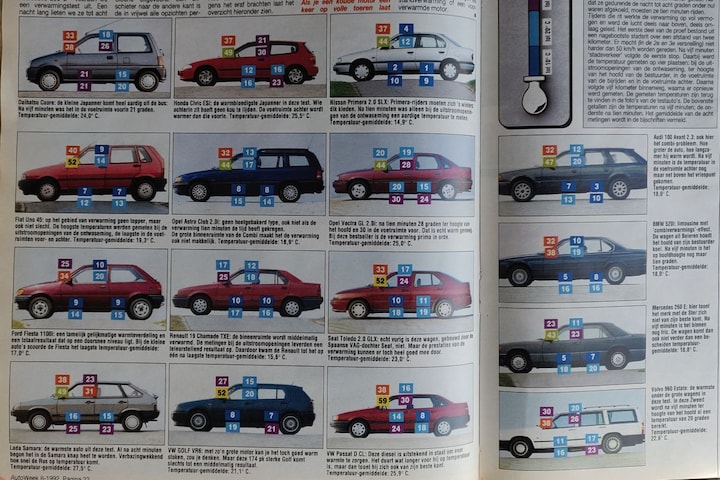In February you can almost smell early spring again, but King Winter is sometimes at its strongest. Thirty years ago, we thought it was a good time to find out in which car you warm up the fastest. A large test had to show in which car the heating could make things pleasant the fastest.
In 1992, we gathered a whole host of current cars to find out which had the most efficient onboard heater. Sixteen pieces, to be exact. The Daihatsu Cuore, Honda Civic, Nissan Primera, Fiat Uno, Opel Astra, Opel Vectra, Audi 100, Ford Fiesta, Renault 19, Seat Toledo, BMW 5 Series, Lada Samara, Volkswagen Golf, Volkswagen Passat, Mercedes 200 Series and Volvo 960. To achieve the most reliable result, all cars were of course tested under the same conditions.
The test went like this: “After they had cooled down to eight degrees below zero overnight, they had to drive for ten minutes. During the ride, the heating was working at full power and the air was led partly up and partly down. The first part of the test consisted of a simulated city ride over a distance of two kilometres, with a speed limit of 50 km/h (in second and third gears) and the first stop after five minutes of ‘urban traffic’. The temperature was measured in four places: at the demisting vents, at the driver’s head, in the passenger’s footwell and in the rear footwell, followed by five kilometers of back roads, after which measurements were taken again. temperatures can be found in the photos of the test cars. The top numbers are the temperatures after five minutes, the bottom after ten minutes. The average of the eight measurements is stated in the captions ld.”

The research led to a surprising winner: the Lada Samara. “It was a complete surprise that the cheap Lada outperformed all competitors in this heating test. The engineers from Togliatti certainly carried out the necessary cold tests in Siberia.” In the Samara, the average temperature was 27.5 degrees after the test. As expected, the smaller cars took relatively little time to warm up, so the result of the Volkswagen Passat was also commendable. It finished in second place, despite its larger size. A major setback was the Nissan Primera, where the average temperature was only 14.9 degrees. “After ten minutes a nice temperature could be measured only at the outlet openings of the demisting.” The Renault 19 was also disappointing, with an average temperature of 15.6 degrees.
Temperatures in the large cars were, as expected, significantly lower than in the smaller cars. For example, the Audi 100, BMW 5-series and Mercedes-Benz 200-series remained on average at 18, another 18 and 18.8 degrees respectively. However, the Volvo 960 showed its good side. The average there was significantly higher at 22.6 degrees. We therefore concluded that the heating of cars from cold places was best in order. After all, both the Samara and the 960 were born in places where winters can be long and cold.
Do you also have experience with heating in the winter with one of these cars? Let us know in the comments, we are curious if your experiences match our research from 1992.
– Thanks for information from Autoweek.nl
